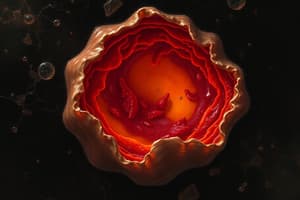Podcast
Questions and Answers
Apoptosis is derived from the Greek word for '____________.'
Apoptosis is derived from the Greek word for '____________.'
falling off
Multicellular organisms need to regulate cell death to allow body structures to grow and develop __________.
Multicellular organisms need to regulate cell death to allow body structures to grow and develop __________.
correctly
During apoptosis, the process begins with the activation of ______ proteins.
During apoptosis, the process begins with the activation of ______ proteins.
procaspase
Apoptosis can be initiated by __________ signaling or intracellular signaling.
Apoptosis can be initiated by __________ signaling or intracellular signaling.
One of the morphological changes in apoptosis is ______ of the cell.
One of the morphological changes in apoptosis is ______ of the cell.
The balance between cell proliferation and cell death is essential for maintaining __________.
The balance between cell proliferation and cell death is essential for maintaining __________.
Programmed cell death is crucial for the removal of body structures that are no longer __________.
Programmed cell death is crucial for the removal of body structures that are no longer __________.
Caspases are specialized intracellular ______ that play a crucial role in apoptosis.
Caspases are specialized intracellular ______ that play a crucial role in apoptosis.
Cell death plays an important role in __________, as it helps eliminate damaged or unwanted cells.
Cell death plays an important role in __________, as it helps eliminate damaged or unwanted cells.
In apoptosis, ______ fragmentation is a characteristic morphological feature.
In apoptosis, ______ fragmentation is a characteristic morphological feature.
The initiator and executioner caspases are two classes of ______ involved in the apoptotic process.
The initiator and executioner caspases are two classes of ______ involved in the apoptotic process.
Apoptosis is essential for processes such as the development of a mouse’s paw and a tadpole losing its __________.
Apoptosis is essential for processes such as the development of a mouse’s paw and a tadpole losing its __________.
In multicellular organisms, precise control over the size of __________ and organs is necessary.
In multicellular organisms, precise control over the size of __________ and organs is necessary.
Caspases are ______: they cleave key cell proteins.
Caspases are ______: they cleave key cell proteins.
The ______ pathway is mediated by death receptors.
The ______ pathway is mediated by death receptors.
During apoptosis, pro-caspase 8 is converted to ______.
During apoptosis, pro-caspase 8 is converted to ______.
The ______ family includes both anti-apoptotic and pro-apoptotic members.
The ______ family includes both anti-apoptotic and pro-apoptotic members.
The ______ activates executioner caspases after receiving apoptotic signals.
The ______ activates executioner caspases after receiving apoptotic signals.
Cad is a downstream target of ______.
Cad is a downstream target of ______.
Adaptor protein ______ recruits initiator caspases in the extrinsic pathway.
Adaptor protein ______ recruits initiator caspases in the extrinsic pathway.
Cell ______ is the process of increasing cell numbers.
Cell ______ is the process of increasing cell numbers.
______ is the process of programmed cell death.
______ is the process of programmed cell death.
The ______ pathway of apoptosis is activated by mitochondrial signals.
The ______ pathway of apoptosis is activated by mitochondrial signals.
DNA damage can trigger apoptosis via the ______ protein.
DNA damage can trigger apoptosis via the ______ protein.
Pathological cell death is referred to as ______.
Pathological cell death is referred to as ______.
Pro-apoptotic proteins such as Bax and Bak belong to the ______ family.
Pro-apoptotic proteins such as Bax and Bak belong to the ______ family.
Cells that have been infected by ______ need to be eliminated by apoptosis.
Cells that have been infected by ______ need to be eliminated by apoptosis.
The process of apoptosis prevents the survival of cells with ______ DNA.
The process of apoptosis prevents the survival of cells with ______ DNA.
______ cells can initiate an autoimmune response if not eliminated.
______ cells can initiate an autoimmune response if not eliminated.
In apoptosis, the cell experiences ______ condensation.
In apoptosis, the cell experiences ______ condensation.
In necrosis, cellular membranes ______ leading to inflammation.
In necrosis, cellular membranes ______ leading to inflammation.
The p53 protein is a tumour suppressor that is mutated in more than ______% of cancers.
The p53 protein is a tumour suppressor that is mutated in more than ______% of cancers.
Apoptosis plays an important role in preventing ______, but is not always successful.
Apoptosis plays an important role in preventing ______, but is not always successful.
In cancer cells, the cues that would trigger ______ have failed.
In cancer cells, the cues that would trigger ______ have failed.
The survival of lymphocytes that would normally have ______ is a characteristic of cancer.
The survival of lymphocytes that would normally have ______ is a characteristic of cancer.
The cell develops resistance to ______, which is a common factor in cancer progression.
The cell develops resistance to ______, which is a common factor in cancer progression.
The p53 protein is a tumour suppressor that promotes __________ following DNA damage.
The p53 protein is a tumour suppressor that promotes __________ following DNA damage.
When apoptosis is inhibited, the result can be the __________ of lymphocytes that would normally have died.
When apoptosis is inhibited, the result can be the __________ of lymphocytes that would normally have died.
Mutations in p53 lead to a failure to promote __________ or cell cycle arrest.
Mutations in p53 lead to a failure to promote __________ or cell cycle arrest.
Cells can develop __________ to apoptosis, which is a critical aspect of cancer development.
Cells can develop __________ to apoptosis, which is a critical aspect of cancer development.
Apoptosis is initiated by the activation of ______ proteins.
Apoptosis is initiated by the activation of ______ proteins.
Caspases are specialized intracellular ______ that cleave specific proteins during apoptosis.
Caspases are specialized intracellular ______ that cleave specific proteins during apoptosis.
Necrosis causes an inflammatory response but ______ does not.
Necrosis causes an inflammatory response but ______ does not.
To eliminate lymphocytes that would trigger an ______ response
To eliminate lymphocytes that would trigger an ______ response
Apoptosis is known as ______ cell death or programmed cell death.
Apoptosis is known as ______ cell death or programmed cell death.
Necrosis is a type of cell death that is ______ resulting from damage or injury.
Necrosis is a type of cell death that is ______ resulting from damage or injury.
During apoptosis, the cell membranes remain ______ and do not rupture.
During apoptosis, the cell membranes remain ______ and do not rupture.
The process of apoptosis helps to get rid of ______ cells that are no longer needed.
The process of apoptosis helps to get rid of ______ cells that are no longer needed.
In apoptosis, the cellular DNA undergoes ______ fragmentation.
In apoptosis, the cellular DNA undergoes ______ fragmentation.
In necrosis, damage leads to cellular ______, which results in inflammation.
In necrosis, damage leads to cellular ______, which results in inflammation.
Apoptosis is essential for the removal of cells that may have ______ DNA.
Apoptosis is essential for the removal of cells that may have ______ DNA.
Programmed cell death is essential for the removal of body structures that are no longer __________.
Programmed cell death is essential for the removal of body structures that are no longer __________.
Caspase-activated DNase (CAD) is responsible for cutting DNA between __________.
Caspase-activated DNase (CAD) is responsible for cutting DNA between __________.
The initiator caspase in the extrinsic pathway is __________.
The initiator caspase in the extrinsic pathway is __________.
The intrinsic pathway of apoptosis involves the release of __________ from the mitochondria.
The intrinsic pathway of apoptosis involves the release of __________ from the mitochondria.
In the extrinsic pathway, adaptor protein __________ recruits initiator caspases.
In the extrinsic pathway, adaptor protein __________ recruits initiator caspases.
The protein __________ is known to inhibit apoptosis and is associated with many tumors.
The protein __________ is known to inhibit apoptosis and is associated with many tumors.
During apoptosis, the cell's nuclear lamins undergo __________.
During apoptosis, the cell's nuclear lamins undergo __________.
The clustering of __________ triggers a conformational change that activates procaspases.
The clustering of __________ triggers a conformational change that activates procaspases.
Pro-apoptotic proteins such as __________ lead to the activation of executioner caspases.
Pro-apoptotic proteins such as __________ lead to the activation of executioner caspases.
In the DISC, __________ is the ligand that binds to the death receptors.
In the DISC, __________ is the ligand that binds to the death receptors.
What morphological change is NOT typically associated with apoptosis?
What morphological change is NOT typically associated with apoptosis?
Which statement accurately represents a difference between apoptosis and necrosis?
Which statement accurately represents a difference between apoptosis and necrosis?
Which component is essential for the apoptosis process?
Which component is essential for the apoptosis process?
Which stage is NOT part of the mechanism of apoptosis?
Which stage is NOT part of the mechanism of apoptosis?
What is a characteristic feature of the caspase proteins involved in apoptosis?
What is a characteristic feature of the caspase proteins involved in apoptosis?
What is the role of the p53 protein in relation to apoptosis when mutated?
What is the role of the p53 protein in relation to apoptosis when mutated?
Which statement correctly explains the relationship between apoptosis and cancer?
Which statement correctly explains the relationship between apoptosis and cancer?
What characteristic is exhibited by lymphocytes in the presence of cancer?
What characteristic is exhibited by lymphocytes in the presence of cancer?
How does a mutation in p53 affect its role as a tumor suppressor?
How does a mutation in p53 affect its role as a tumor suppressor?
Which process is NOT typically associated with cancer cell development?
Which process is NOT typically associated with cancer cell development?
Why is precise control over cell death important for multicellular organisms?
Why is precise control over cell death important for multicellular organisms?
What is a characteristic effect of apoptosis as opposed to necrosis?
What is a characteristic effect of apoptosis as opposed to necrosis?
Which of the following describes a consequence of malfunctioning apoptosis?
Which of the following describes a consequence of malfunctioning apoptosis?
What role do caspases play in apoptosis?
What role do caspases play in apoptosis?
What initiates the process of apoptosis in cells?
What initiates the process of apoptosis in cells?
How does cell death contribute to homeostasis within tissues?
How does cell death contribute to homeostasis within tissues?
What is a likely effect of dysregulated apoptosis in cancer development?
What is a likely effect of dysregulated apoptosis in cancer development?
Which factor is commonly associated with apoptosis in the context of pathogen-infected cells?
Which factor is commonly associated with apoptosis in the context of pathogen-infected cells?
What is one of the distinct characteristics of apoptosis?
What is one of the distinct characteristics of apoptosis?
Which of the following is a function of apoptosis?
Which of the following is a function of apoptosis?
What differentiates necrosis from apoptosis?
What differentiates necrosis from apoptosis?
What role does apoptosis play in organ development?
What role does apoptosis play in organ development?
Which of the following descriptions applies to necrosis?
Which of the following descriptions applies to necrosis?
What initiates apoptosis in response to cellular damage?
What initiates apoptosis in response to cellular damage?
In what context is apoptosis particularly important?
In what context is apoptosis particularly important?
Which type of cell death is described as resulting from injury?
Which type of cell death is described as resulting from injury?
Which component is part of the death-inducing signaling complex (DISC)?
Which component is part of the death-inducing signaling complex (DISC)?
What initiates the intrinsic pathway of apoptosis?
What initiates the intrinsic pathway of apoptosis?
What role does cytochrome c play in apoptosis?
What role does cytochrome c play in apoptosis?
Which statement describes an effect of high levels of Bcl-2 in cells?
Which statement describes an effect of high levels of Bcl-2 in cells?
What is the primary function of caspase-activated DNase (CAD)?
What is the primary function of caspase-activated DNase (CAD)?
What triggers the activation of initiator procaspases in the extrinsic pathway?
What triggers the activation of initiator procaspases in the extrinsic pathway?
Which molecule is directly associated with the activation of executioner caspases in the intrinsic pathway?
Which molecule is directly associated with the activation of executioner caspases in the intrinsic pathway?
Which protein is known to be a pro-apoptotic member of the Bcl-2 family?
Which protein is known to be a pro-apoptotic member of the Bcl-2 family?
How does the extrinsic pathway of apoptosis differ from the intrinsic pathway?
How does the extrinsic pathway of apoptosis differ from the intrinsic pathway?
What occurs as a result of deprivation of survival factors in cells?
What occurs as a result of deprivation of survival factors in cells?
Which of the following statements accurately describes a characteristic of apoptosis?
Which of the following statements accurately describes a characteristic of apoptosis?
What is one key difference between apoptosis and necrosis?
What is one key difference between apoptosis and necrosis?
What role do initiator caspases play in the apoptosis mechanism?
What role do initiator caspases play in the apoptosis mechanism?
Which morphological change is a typical feature observed during apoptosis?
Which morphological change is a typical feature observed during apoptosis?
What protein family is primarily involved in the execution of apoptosis through their proteolytic functions?
What protein family is primarily involved in the execution of apoptosis through their proteolytic functions?
What is the role of the p53 protein in cancerous cells?
What is the role of the p53 protein in cancerous cells?
Which of the following statements best describes the relationship between apoptosis and cancer progression?
Which of the following statements best describes the relationship between apoptosis and cancer progression?
What is a consequence of p53 mutation in relation to lymphocyte survival?
What is a consequence of p53 mutation in relation to lymphocyte survival?
Which process occurs when cancer cells develop resistance to apoptosis?
Which process occurs when cancer cells develop resistance to apoptosis?
How does the over-expression of regulatory proteins relate to cancer cell behavior?
How does the over-expression of regulatory proteins relate to cancer cell behavior?
What role does apoptosis play in multicellular organisms?
What role does apoptosis play in multicellular organisms?
In what scenario does necrosis primarily occur compared to apoptosis?
In what scenario does necrosis primarily occur compared to apoptosis?
What is a significant consequence when apoptosis does not function correctly?
What is a significant consequence when apoptosis does not function correctly?
How does apoptosis contribute to the development of multicellular organisms?
How does apoptosis contribute to the development of multicellular organisms?
Which statement correctly identifies an important function of caspases in apoptosis?
Which statement correctly identifies an important function of caspases in apoptosis?
What is the relationship between apoptosis and homeostasis in the body?
What is the relationship between apoptosis and homeostasis in the body?
What signaling mechanisms are involved in initiating apoptosis?
What signaling mechanisms are involved in initiating apoptosis?
Which statement best distinguishes apoptosis from necrosis?
Which statement best distinguishes apoptosis from necrosis?
Which option is NOT a type of necrosis?
Which option is NOT a type of necrosis?
Which of the following does NOT represent a consequence of apoptosis?
Which of the following does NOT represent a consequence of apoptosis?
Which of the following is a characteristic of necrosis?
Which of the following is a characteristic of necrosis?
What can trigger the process of apoptosis within a cell?
What can trigger the process of apoptosis within a cell?
Which statement regarding T-lymphocytes is accurate?
Which statement regarding T-lymphocytes is accurate?
Which of the following differentiates the outcomes of apoptosis and necrosis?
Which of the following differentiates the outcomes of apoptosis and necrosis?
What is a primary function of apoptosis during development?
What is a primary function of apoptosis during development?
Which initiator caspase is involved in the extrinsic pathway of apoptosis?
Which initiator caspase is involved in the extrinsic pathway of apoptosis?
Which protein family members are generally known for their pro-apoptotic roles?
Which protein family members are generally known for their pro-apoptotic roles?
What occurs in the intrinsic pathway to initiate apoptosis?
What occurs in the intrinsic pathway to initiate apoptosis?
What is a key function of adaptor proteins in apoptosis signaling?
What is a key function of adaptor proteins in apoptosis signaling?
Which of the following statements about Bcl-2 is correct?
Which of the following statements about Bcl-2 is correct?
How do initiator caspases differ from executioner caspases?
How do initiator caspases differ from executioner caspases?
What is the effect of deprivation of survival factors on cells?
What is the effect of deprivation of survival factors on cells?
Which statement best describes the role of p53 in apoptosis?
Which statement best describes the role of p53 in apoptosis?
Which morphological change is characteristic of apoptosis?
Which morphological change is characteristic of apoptosis?
How do caspases contribute to the process of apoptosis?
How do caspases contribute to the process of apoptosis?
What is a key distinction between apoptosis and necrosis?
What is a key distinction between apoptosis and necrosis?
What initiates the apoptotic cascade in cells?
What initiates the apoptotic cascade in cells?
Which of the following is NOT a typical feature of apoptosis?
Which of the following is NOT a typical feature of apoptosis?
What is the primary function of the p53 protein in normal cells regarding apoptosis?
What is the primary function of the p53 protein in normal cells regarding apoptosis?
Which of the following statements accurately describes a consequence of p53 mutation in cancer cells?
Which of the following statements accurately describes a consequence of p53 mutation in cancer cells?
Which factor contributes to the development of cancer in relation to apoptosis?
Which factor contributes to the development of cancer in relation to apoptosis?
What is one possible outcome when apoptosis is inhibited in cells?
What is one possible outcome when apoptosis is inhibited in cells?
Which of the following processes is NOT associated with the failure of apoptosis in cancer development?
Which of the following processes is NOT associated with the failure of apoptosis in cancer development?
What is an essential role of caspases in apoptosis?
What is an essential role of caspases in apoptosis?
Which initiator caspase is involved in the extrinsic pathway?
Which initiator caspase is involved in the extrinsic pathway?
What forms the death-inducing signaling complex (DISC)?
What forms the death-inducing signaling complex (DISC)?
Which protein is released from the mitochondria to activate the intrinsic pathway?
Which protein is released from the mitochondria to activate the intrinsic pathway?
Increased levels of which Bcl-2 family member are associated with cancer?
Increased levels of which Bcl-2 family member are associated with cancer?
What is the primary function of the apoptosome?
What is the primary function of the apoptosome?
What consequence arises from the deprivation of survival factors in cells?
What consequence arises from the deprivation of survival factors in cells?
What triggers the activation of procaspases in the apoptotic signaling process?
What triggers the activation of procaspases in the apoptotic signaling process?
Which of the following is a pro-apoptotic member of the Bcl-2 family?
Which of the following is a pro-apoptotic member of the Bcl-2 family?
Which signaling pathway primarily involves death receptors?
Which signaling pathway primarily involves death receptors?
What is the primary characteristic that differentiates apoptosis from necrosis?
What is the primary characteristic that differentiates apoptosis from necrosis?
Which of the following best describes apoptosis?
Which of the following best describes apoptosis?
During which process is cellular DNA fragmented in a ladder-like pattern?
During which process is cellular DNA fragmented in a ladder-like pattern?
What role does apoptosis play in the immune system?
What role does apoptosis play in the immune system?
What is one difference between coagulating necrosis and liquifying necrosis?
What is one difference between coagulating necrosis and liquifying necrosis?
Why do multicellular organisms need to regulate cell death?
Why do multicellular organisms need to regulate cell death?
Which of the following is NOT a known function of apoptosis?
Which of the following is NOT a known function of apoptosis?
What happens to the cell during necrosis?
What happens to the cell during necrosis?
What is one major reason multicellular organisms need to regulate cell death?
What is one major reason multicellular organisms need to regulate cell death?
Which mechanism initiates apoptosis?
Which mechanism initiates apoptosis?
What happens when apoptosis goes wrong?
What happens when apoptosis goes wrong?
What distinguishes apoptosis from necrosis?
What distinguishes apoptosis from necrosis?
Which of the following is an important molecule associated with apoptosis?
Which of the following is an important molecule associated with apoptosis?
How does apoptosis contribute to homeostasis?
How does apoptosis contribute to homeostasis?
What is the result of inhibited apoptosis in multicellular organisms?
What is the result of inhibited apoptosis in multicellular organisms?
Flashcards
Apoptosis
Apoptosis
A natural process where cells self-destruct in a controlled manner, essential for proper development and maintaining tissue balance.
Programmed Cell Death
Programmed Cell Death
A programmed cell death mechanism that involves a chain reaction of biochemical events leading to cell dismantling.
Cell Death
Cell Death
The process by which a multicellular organism eliminates unwanted or damaged cells to maintain proper function and development.
Cell Replenishment
Cell Replenishment
Signup and view all the flashcards
Removal of Unneeded Structures
Removal of Unneeded Structures
Signup and view all the flashcards
Clearing Damaged Cells
Clearing Damaged Cells
Signup and view all the flashcards
Apoptosis gone wrong
Apoptosis gone wrong
Signup and view all the flashcards
Necrosis
Necrosis
Signup and view all the flashcards
Cell division (Proliferation)
Cell division (Proliferation)
Signup and view all the flashcards
T-Lymphocyte killing a virally infected cell
T-Lymphocyte killing a virally infected cell
Signup and view all the flashcards
NK cell killing a virally infected cell
NK cell killing a virally infected cell
Signup and view all the flashcards
Apoptosis' role in organ development
Apoptosis' role in organ development
Signup and view all the flashcards
Apoptosis' role in immune system balance
Apoptosis' role in immune system balance
Signup and view all the flashcards
What does p53 do?
What does p53 do?
Signup and view all the flashcards
What happens when p53 is mutated?
What happens when p53 is mutated?
Signup and view all the flashcards
What is Apoptosis?
What is Apoptosis?
Signup and view all the flashcards
How is apoptosis linked to cancer?
How is apoptosis linked to cancer?
Signup and view all the flashcards
Why is cell death important?
Why is cell death important?
Signup and view all the flashcards
What are the morphological changes characteristic of apoptosis?
What are the morphological changes characteristic of apoptosis?
Signup and view all the flashcards
What are caspases and their role in apoptosis?
What are caspases and their role in apoptosis?
Signup and view all the flashcards
Explain the caspase cascade in apoptosis.
Explain the caspase cascade in apoptosis.
Signup and view all the flashcards
What are the targets of caspase activity in apoptosis?
What are the targets of caspase activity in apoptosis?
Signup and view all the flashcards
Bcl-2 Family
Bcl-2 Family
Signup and view all the flashcards
Caspase Cascade
Caspase Cascade
Signup and view all the flashcards
Death-Inducing Signaling Complex (DISC)
Death-Inducing Signaling Complex (DISC)
Signup and view all the flashcards
p53
p53
Signup and view all the flashcards
Extrinsic Pathway
Extrinsic Pathway
Signup and view all the flashcards
Intrinsic Pathway
Intrinsic Pathway
Signup and view all the flashcards
Cytochrome C
Cytochrome C
Signup and view all the flashcards
Mitochondrial Permeability Transition Pore (MPTP)
Mitochondrial Permeability Transition Pore (MPTP)
Signup and view all the flashcards
Apaf-1 (Apoptotic Protease Activating Factor-1)
Apaf-1 (Apoptotic Protease Activating Factor-1)
Signup and view all the flashcards
Study Notes
Cell Death
- Cell death is crucial for life, vital for development and homeostasis.
- Apoptosis is a form of programmed cell death, also known as physiological or normal cell death, and helps in getting rid of unwanted cells.
- Apoptosis is "Greek for falling off."
- Apoptosis differs from necrosis, a form of pathological cell death, which is caused by damage or injury.
- Necrosis results in cell swelling and rupture of membranes.
- Apoptosis involves cellular condensation, intact membranes, requiring ATP, and is phagocytosed with no tissue reaction or inflammation.
- Apoptosis is a regulated process resulting in organized DNA fragmentation, while necrosis results in random DNA fragmentation.
- Apoptosis is triggered at the individual cell level, whereas necrosis affects whole areas of tissue.
- Cell death's importance lies in shaping organs during development and maintaining homeostasis.
Learning Outcomes
- Students should describe the importance of cell death.
- They should differentiate between types of cell death.
- Students should interpret cell death signaling pathways.
- The key molecules involved in cell death should be identified.
- The role of cell death in disease needs to be explained.
Apoptosis versus Necrosis
- Apoptosis is a controlled or programmed process of cellular suicide.
- Necrosis is a uncontrolled or pathological process resulting from damaged cells.
- Apoptosis results in a condensation of the cell and leaves intact membranes, and no inflammation.
- Necrosis involves cell swelling and rupture, leading to subsequent inflammation.
- The breakdown of DNA in apoptosis is organized, whereas in necrosis, the process is random.
Types of Necrosis
- Coagulative necrosis is a type of tissue necrosis characterized by the preservation of the basic tissue architecture, typically seen after ischemia or infarction, particularly in the heart and kidneys.
- Liquefactive necrosis, on the other hand, involves the transformation of tissues into a liquid viscous mass, often occurring due to bacterial infections or brain damage, resulting in pus formation.
Apoptosis Morphology
- Features include cell shrinkage, organelle reduction, mitochondrial leakage, chromatin condensation, nuclear fragmentation, and membrane blebbing and changes.
Apoptosis Signaling
- Apoptosis signaling has two pathways: intrinsic and extrinsic.
- The extrinsic pathway of apoptosis primarily involves the activation of death receptors located on the cell membrane, which, upon clustering, initiate a signaling cascade leading to programmed cell death. This process is often triggered by external signals such as cytokines or ligands.
- Conversely, the intrinsic pathway is mediated by the mitochondria and is activated in response to internal cellular stress, such as DNA damage or oxidative stress. This pathway involves the release of pro-apoptotic factors from the mitochondria, which then activate caspases, ultimately leading to cell death.
Apoptosis and Procaspases
- Apoptosis involves specialized intracellular proteases called caspases.
- Caspases cleave specific amino acid sequences in proteins.
- They are synthesized as inactive procaspases and require activation.
- Procaspases are inactive precursors of caspases that play critical roles as initiators and executioners in the apoptosis pathway.
Caspase Cascade
- Caspase activation proceeds in a cascade.
- The active caspases initiate a cascade of activating downstream targets.
Caspase Targets
- Caspases cleave key cell proteins like DNAse, nuclear lamins, and actin-digesting enzymes.
- This leads to the fragmentation of cellular structures like DNA and the nucleus.
- This eventually leads to cytoskeletal disassembly.
Caspase-activated DNase (CAD)
- CAD is involved in the cutting of DNA between nucleosomes.
- Active CAD is activated by executioner caspases.
Extrinsic Pathway Details
- This pathway is initiated from outside the cell.
- Death receptors such as Fas and TNF are involved.
- Ligands bind to these receptors, leading to the formation of the death-inducing signaling complex (DISC).
- Caspase 8 is a key component of the extrinsic apoptosis pathway, which is triggered by death receptors on the cell surface. It acts as an initiator caspase, being one of the first to be activated in response to death signals. Once activated, Caspase 8 not only cleaves and activates downstream effector caspases, such as Caspase 3 and Caspase 7, but it also plays a role in amplifying the apoptotic signal within the cell. This makes Caspase 8 crucial for the orderly and efficient dismantling of the cell during apoptosis, contributing to the overall regulation and execution of programmed cell death processes.
Intrinsic Pathway Details
- This pathway is activated from inside the cell.
- The Bcl-2 family proteins play a crucial regulatory role in the apoptosis pathway, influencing cell survival and death decisions.
- The release of cytochrome c from the mitochondria serves as a crucial event in the intrinsic apoptosis pathway. This release indicates cellular stress or damage and subsequently leads to the activation of Apaf-1, which facilitates the recruitment of Caspase 9, further propagating the apoptotic signal.
- Apoptotic protease activating factor-1 (APAF-1) is a crucial regulatory protein that plays an essential role in the intrinsic apoptosis pathway, acting as a key initiator in the activation of caspases.
Cellular Level Death
- Death is necessary for life at the cellular level
- The importance for multicellular organisms is to remove unwanted cells, for development, and maintenance of homeostasis.
P53
- The p53 protein is a tumour suppressor that responds to DNA damage.
- It plays a role in apoptosis and cell cycle arrest.
- Mutations in the p53 tumor suppressor gene are prevalent across various types of cancers, frequently leading to a diminished ability of cells to undergo apoptosis in response to DNA damage, thus allowing damaged cells to survive and proliferate.
Bcl-2 Family
- These proteins control the intrinsic pathway of apoptosis.
- Bcl-2 family proteins are central to the regulation of the apoptotic process, as they include both anti-apoptotic members, which inhibit cell death, and pro-apoptotic members, which facilitate apoptosis.
- This uncontrolled growth may result in various conditions, including cancer, where cells reproduce without the normal regulatory checks and balances.
Cancer and Apoptosis
- Apoptosis can be linked to cancer or tumor development if uncontrolled cell death does not occur appropriately.
- Cancer cells may evade apoptosis or exhibit uncontrolled proliferation due to failure in apoptosis regulation.
Studying That Suits You
Use AI to generate personalized quizzes and flashcards to suit your learning preferences.




